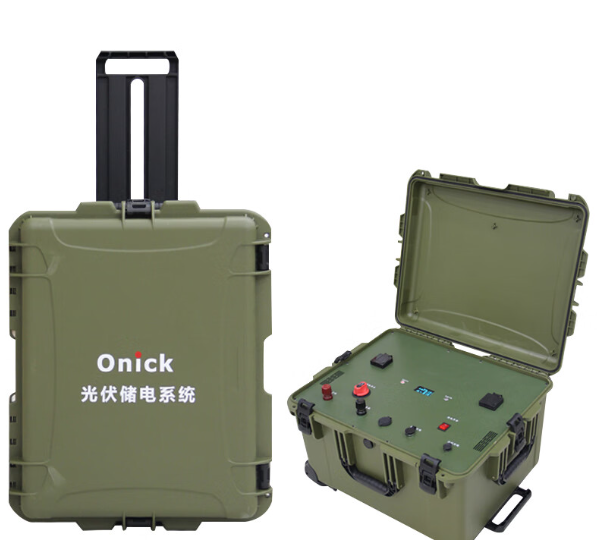Amid the global energy transition, photovoltaic (PV) energy storage systems are becoming a new favorite in the energy sector due to their unique advantages. Combining solar energy, an inexhaustible clean energy source, with efficient energy storage technology, they not only revolutionize energy supply but also play a vital role in promoting sustainable development.
I. Basic Components of PV Energy Storage Systems
PV energy storage systems primarily consist of solar panels, energy storage batteries, inverters, and control systems. These components work together to convert, store, and supply energy.
Solar PV panels are the system's "energy harvesters," typically composed of multiple solar cells. These cells utilize the photovoltaic effect, converting sunlight directly into electricity when exposed to sunlight. They are installed on rooftops, ground, or other well-lit locations to maximize solar energy absorption.
Energy storage batteries serve as the system's "energy warehouse," storing excess electricity generated by the PV panels. Common energy storage batteries include lithium-ion batteries and lead-acid batteries. Lithium-ion batteries are increasingly used in photovoltaic energy storage systems due to their high energy density and long cycle life. Lead-acid batteries are relatively inexpensive, but their energy density and lifespan are slightly inferior.
The inverter is the system's "energy converter," converting the direct current (DC) generated by the photovoltaic panels into alternating current (AC) for direct use in homes or industrial equipment. During energy storage, it also converts the DC power into a form suitable for battery storage and converts the battery's DC output back into AC during discharge.
The control system is the "brain" of the photovoltaic energy storage system, monitoring the power generation of the photovoltaic panels, the charge level of the energy storage batteries, and the power demand of the loads in real time. Based on this information, the control system intelligently regulates the flow of energy to ensure efficient and stable system operation. For example, when the power generation of the photovoltaic panels exceeds the power consumption of the loads, the control system stores the excess energy in the energy storage batteries. When power generation is insufficient, the control system automatically draws on the energy storage batteries to supplement the system's power.
II. Working Principle of the Photovoltaic Energy Storage System
The photovoltaic energy storage system has a clear and efficient workflow, fully demonstrating the intelligent utilization of clean energy. During the day, when sunlight is available, solar photovoltaic panels generate direct current (DC) electricity. A portion of this DC electricity is converted to AC by an inverter, directly supplying loads such as household appliances and industrial equipment to meet real-time power needs.
When the power generated by the PV panels exceeds the load's power consumption, the excess DC power is processed by the inverter under the control of the control system and stored in energy storage batteries. This prevents waste of excess energy and ensures efficient energy storage.
At night, when there is no sunlight or when the light is insufficient, such as on cloudy days, the PV panels cannot generate sufficient power. In this case, the control system automatically switches to discharge the energy storage batteries. The DC power released by the batteries is also converted to AC by the inverter to continue powering the load, ensuring continuous power supply. In addition, in some cases, when the energy storage battery is fully charged and the photovoltaic panels still have surplus power, the system can also connect the excess power to the grid and sell it. When the photovoltaic panels are generating insufficient power and the energy storage battery is also low, the system can purchase power from the grid to supplement the power demand, forming a flexible energy interactive cycle.
III. Analysis of the Core Equipment of the Photovoltaic Energy Storage System
(I) Solar Photovoltaic Panels
The performance of solar photovoltaic panels directly affects the power generation efficiency of the system. Its main parameters include conversion efficiency and power. The higher the conversion efficiency, the more power it generates under the same lighting conditions. Currently, the conversion efficiency of common photovoltaic panels on the market is around 15%-25%. With continuous technological advancements, high-efficiency panels are gradually becoming popular.
Photovoltaic panels are made of a variety of materials, with monocrystalline silicon, polycrystalline silicon, and thin-film photovoltaic panels being the most common types. Monocrystalline silicon panels offer high conversion efficiency and stable performance, but are relatively expensive. Polycrystalline silicon panels are lower in cost, but have slightly lower conversion efficiency than monocrystalline silicon. Thin-film photovoltaic panels are flexible and bendable, making them suitable for some specialized installation scenarios. (II) Energy Storage Batteries
The main performance indicators of energy storage batteries include capacity, cycle life, and charge/discharge efficiency. Capacity determines how much energy a battery can store; the larger the capacity, the greater the energy storage capacity. Cycle life refers to the number of charge and discharge cycles a battery can undergo; the longer the cycle life, the longer the battery life. Charge/discharge efficiency refers to the ratio of energy stored during charging to energy released during discharging. The higher the efficiency, the less energy loss.
Different types of energy storage batteries have different focuses. Lithium-ion batteries, such as lithium iron phosphate batteries, offer advantages such as high safety and long cycle life and are widely used in home and commercial photovoltaic power storage systems. Lead-acid batteries, while having a shorter cycle life, are inexpensive and are still used in some cost-sensitive small systems.
(III) Inverters
Inverters can be categorized by function as centralized inverters, string inverters, and microinverters. Centralized inverters are suitable for large-scale photovoltaic power plants, converting the DC power generated by numerous photovoltaic panels into AC power. String inverters can track the maximum power point of individual photovoltaic strings, improving system efficiency under complex lighting conditions and are therefore suitable for small and medium-sized photovoltaic systems. Microinverters are connected to individual photovoltaic panels, further enhancing system performance and reliability.
Inverter conversion efficiency is also a key parameter. High-efficiency inverters reduce energy losses during the conversion process, improving overall system energy efficiency.

IV. Advantages of Photovoltaic Energy Storage Systems(I) Utilizing Clean Energy and Reducing Environmental Pollution
Solar energy is a clean energy source that produces no pollutants such as carbon dioxide and sulfur dioxide, nor does it generate noise pollution. Photovoltaic energy storage systems, using solar energy as their primary energy source, significantly reduce reliance on traditional fossil fuels, thereby reducing greenhouse gas emissions, improving the ecological environment, and promoting green and sustainable development.
(II) Improving Energy Self-Sufficiency and Lowering Electricity Costs
After installing a photovoltaic energy storage system, users can utilize a large amount of their own solar power, reducing the amount of electricity purchased from the grid and improving their energy self-sufficiency. Especially in areas with high electricity prices, long-term use can significantly reduce electricity costs. Furthermore, when the system generates surplus electricity and sells it to the grid, it can also generate certain economic benefits for users.
(III) Enhancing Power Supply Stability and Reliability
In areas with unstable power grids or frequent power outages, photovoltaic energy storage systems can play a vital role. In the event of a grid failure, the system can switch to off-grid operation, relying on the energy stored in the storage battery to continue powering the load, ensuring the normal operation of critical equipment and improving the stability and reliability of the power supply.
V. Application Scenarios of Photovoltaic Energy Storage Systems
(I) Residential
Homes are a key application scenario for photovoltaic energy storage systems. Installing photovoltaic panels on the roof, combined with energy storage batteries and inverters, can meet a household's daily electricity needs. Solar power is generated during the day for household use, and excess electricity is stored. This stored energy is then used at night, resulting in energy savings and environmental protection, while also reducing electricity bills.
(II) Commercial and Industrial Sector
Commercial and industrial enterprises consume large amounts of electricity and incur high electricity bills. Installing a photovoltaic energy storage system can effectively reduce electricity costs. At the same time, during peak electricity demand periods, the system can reduce power purchases from the grid, alleviating pressure on the grid. In emergencies such as power outages, it can also ensure the normal operation of critical enterprise equipment and minimize losses caused by outages.
(III) Remote Areas and Off-Grid Scenarios
In some remote areas and islands, where the grid is not accessible, photovoltaic energy storage systems have become the primary power supply method. They can provide stable electricity to local residents and facilities, resolving electricity shortages and improving local living and production conditions.
(IV) Large-Scale Photovoltaic Power Plants
Large-scale photovoltaic power plants combined with energy storage systems can better cope with the volatility and intermittency of solar power generation. By storing excess energy in energy storage systems and releasing it during peak demand or periods of low sunlight, they improve the stability and controllability of the photovoltaic power plant's power supply to the grid and promote the large-scale application of solar power.

VI. Development Trends of Photovoltaic Energy Storage Systems
With continuous technological innovation and gradually decreasing costs, the development prospects of photovoltaic energy storage systems are promising. On the technological front, the conversion efficiency of solar photovoltaic modules will continue to improve, while costs will continue to decline. The energy density, cycle life, and safety of energy storage batteries will continue to improve, and new battery technologies, such as solid-state batteries, are expected to achieve breakthroughs and be widely adopted. The intelligence level of inverters will also continue to increase, enabling them to better adapt to complex grid environments and diverse load demands.
On the policy front, countries around the world are increasingly prioritizing clean energy, and have introduced a series of policies and measures to support the development of photovoltaic energy storage systems, such as subsidies and tax incentives, providing strong policy support for the industry's development.
On the market side, with growing environmental awareness and the pursuit of energy independence, market demand for photovoltaic energy storage systems will continue to expand, and their application scenarios will become more diverse. Furthermore, with the development of the energy internet, photovoltaic energy storage systems will be more closely integrated with smart grids, electric vehicles, and other technologies, forming a more efficient and intelligent energy ecosystem.
In short, as a key means of utilizing clean energy, photovoltaic energy storage systems are transforming the energy landscape with their unique advantages. They not only bring tangible economic and environmental benefits to individuals and businesses, but also contribute significantly to global energy transformation and sustainable development. I believe that in the future, photovoltaic power storage systems will play a more important role in the energy field.


